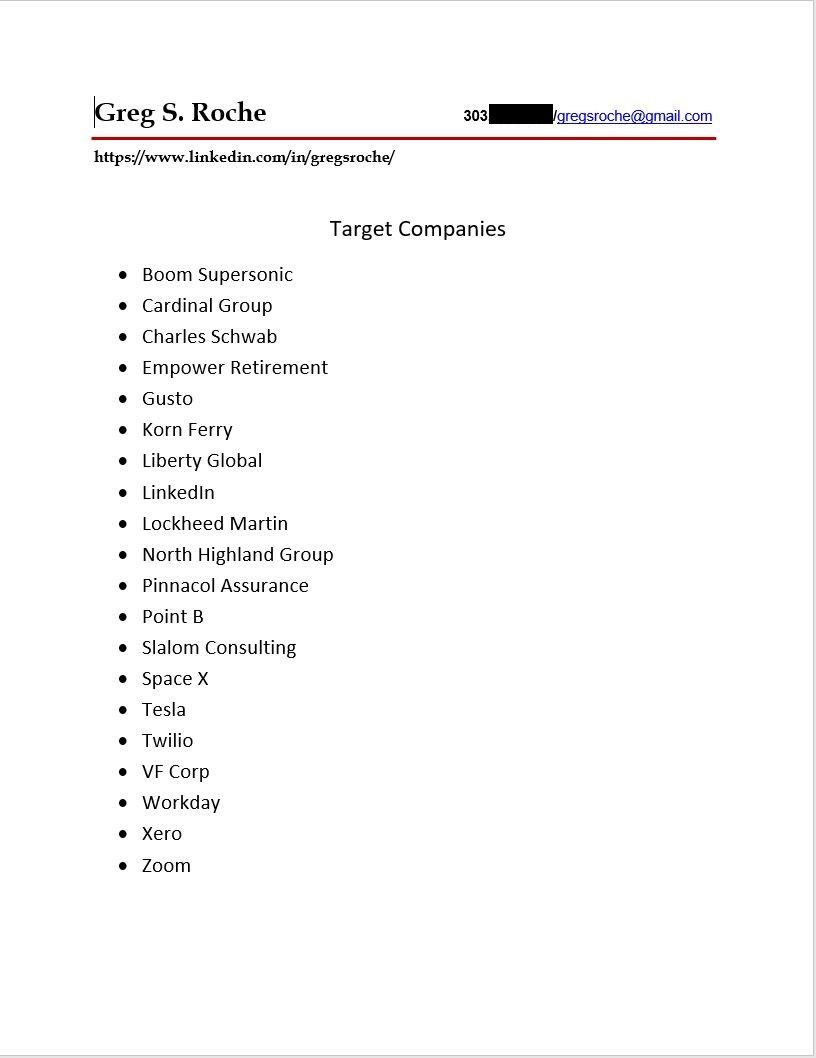How To Create Your Target Company List
The simple tool that gives your networking focus and direction.
Welcome to issue #165 of The Introverted Networker. This issue is Part 6 in a seven-part series called “7 Weeks To Better Networking.” If you want to see where we’re going and where we’ve been, I’ve laid out the entire series for you. If you like this series, share it with a friend.
This issue takes about 7 minutes to read…
7 Weeks To Better Networking Series Extras:
Get Your Personalized 5-Step Networking Plan. It’s a comprehensive toolkit that combines years of content from my book, this newsletter, my course, and all my LinkedIn posts with user-friendly resources.
My online course, “5 Steps To Grow Your Professional Network,” will teach you the process I use everyday to grow my professional network.
As always, I have lots more networking advice on The Introverted Networker YouTube channel.
How To Make Your Networking Easier
When you’re networking without direction, it’s hard for people to help you.
Photo by Vitaly Gariev on Unsplash
That’s why creating a Target Company List (or, for business owners, an Ideal Client List) changes everything.
I posted the original newsletter showed you how to create this back in 2022.
What still holds:
A clear list gives your networking focus and momentum.
It helps your connections think of specific people to introduce you to.
It turns vague networking into targeted action that leads to real opportunities.
What I’d add now:
This process isn’t just for job seekers. Consultants and business owners can do it, too by defining what their ideal customer says when describing the problem they solve.
The more specific you are, the easier you make it for others to help you.
A written, professional-looking list stands out and sparks ideas for your connections.
If you haven’t made your list yet, this week is about getting it out of your head and onto paper so your network knows exactly how to help you.
How To Make New Connections
Last week, I explained the why you need a target company list.
This week, I’m going to help you create your list.
Let’s start with the normal questions I get about the Target Company List (TCL):
How many companies should be on it?
Does it have to be a formal list?
What companies should I put on it?
Starting with the first one: You should have between 10 and 20 companies on your list.
If you want more, no problem, but I wouldn’t do more than three dozen.
You need enough companies to create the opportunity for your connections to know someone at one of them without overwhelming them.
This is a goldilocks situation - enough, but not too much.
Second, since you’re handing this to people in-person or emailing it to them, your TCL should be formatted and look professional. Much like a resume.
Here’s what mine looks like:
Last, how do you figure out which companies to put on this list?
It’s easy to overthink this, but my suggestion is to get started and use several of the ideas listed below to create your TCL.
10 Ways To Create Your TCL
Dream Companies - Where have you always wanted to work? Maybe it’s the FAANG companies or Disney or Pixar, or the hot local startup. Maybe it’s one that you’ve heard lots of good things about. Maybe it’s your hometown sports team’s front office. Add your dream companies to the list no matter how crazy. You never know when one of your connections might know someone who works there.
Best Place To Work - Search “Best places to work «enter your city name».” Most cities have a list of the best places to work. These are based on surveys run by the local newspapers or magazines. Depending on the list, these are often broken into categories by company size. Scroll through the list and read about the companies. If they’re interesting, add them to your TCL.
Existing Connections - One of the best ways to figure out where you want to work is to find out where the people you already know work.
Go to LinkedIn→My Network→Connections→Search with filters
Revise the Locations to your current city or the city you want to work in
Scroll through your 1st degree connections and look at where they work
Add companies you’re interested in to the list
The best part about identifying where your existing connections work is that you already know someone that works there
Former Co-Workers - An extension of #3 is take the company name of the last place you worked and enter it into LinkedIn’s search in the Past Company field.
Go to LinkedIn→My Network→Connections→Search with filters
Click All Filters
Scroll to the Past Company section
Add names of the companies where you worked in the past
You may want to revise the Location to your current city
Identify former co-workers you’ve lost touch with. Connect with them and add their company’s name to your list
Again, you’ll already have a connection at these companies when you re-connect with former co-workers.
Competitors of your current company - Yes, sometimes there are non-competes, but let’s worry about that later; for now, we’re creating a target list. What company do you work for and who are the main competitors? This also works for any of the other companies you have already added to your list.
Job postings - I don’t recommend you apply for jobs online, but you can use online job boards like Indeed or LinkedIn to see which companies are posting jobs you are interested in. Enter your desired title and see what comes up. What are the names of the companies? Research them and add them to your list.
Career Fairs - This works well for college students. Which companies are at the career fair? Add them to your list. Could also work without even going to the career fair. Find one online and see which companies will be there. Add the ones you are interested in to your TCL.
Glassdoor - Look at the top rated companies in your industry. Also use it to review the companies already on your list. You may make some additions or subtractions based on the reviews.
Friends and family - Where do they work? You may want to work somewhere other than friends or family, but combine this with #5 to get more ideas for your list.
Take a drive - Sounds weird right? Drive around the area you live. Which companies advertise on billboards? Which ones have names on the sides of buildings? Could these be places you might want to work. It may be a long shot, but it also might start some creative thinking.
No matter which companies are on your list, do your research.
Find out what they do.
What do they post on social media?
What do their employees post?
What do they claim as their mission and values?
Do these things resonate with you?
As you start to put your list together, remember what this is going to be used for:
You are going to give this to your connections and ask if they know someone who works at these companies.
Your connections might know someone or they might not.
They may give you suggestions on the names of other companies you don’t have on your list.
Be open to making changes.
You’re not going to laminate it after you make it.
And don’t limit yourself to these companies in your job search.
This is a tool to focus the mind of your connection so he can think of someone he knows at one of these companies or at another company where he knows someone.
When you get that name, you are going to connect with that person and use all the steps you’ve already learned to connect, start the conversation, listen and give, and be easy to help.
How To Put This Into Action?
Do this today:
Open a new document and title it Target Company List (or Ideal Client List).
Start listing companies you’d love to work for or, if you run a business, write the words your ideal customer might say to describe their problem.
Don’t overthink it.
Get it started and commit to refining it for 5–15 minutes each day.
Avoid this pitfall
Don’t keep this list in your head.
Make it a real document you can send or hand to people.
That small act turns a vague idea into a powerful tool others can use to connect you.
What’s Next?
Next week, we’re going to review my entire networking process and talk about how to make it a daily habit.
Follow all 7 Weeks to Better Networking posts to keep building your Connection Loop.
Best Things I Found Online This Week:
JP Elliott shares how he networked his way into his first job out of graduate school by sending Harvard Business Review articles to alumni of his school




